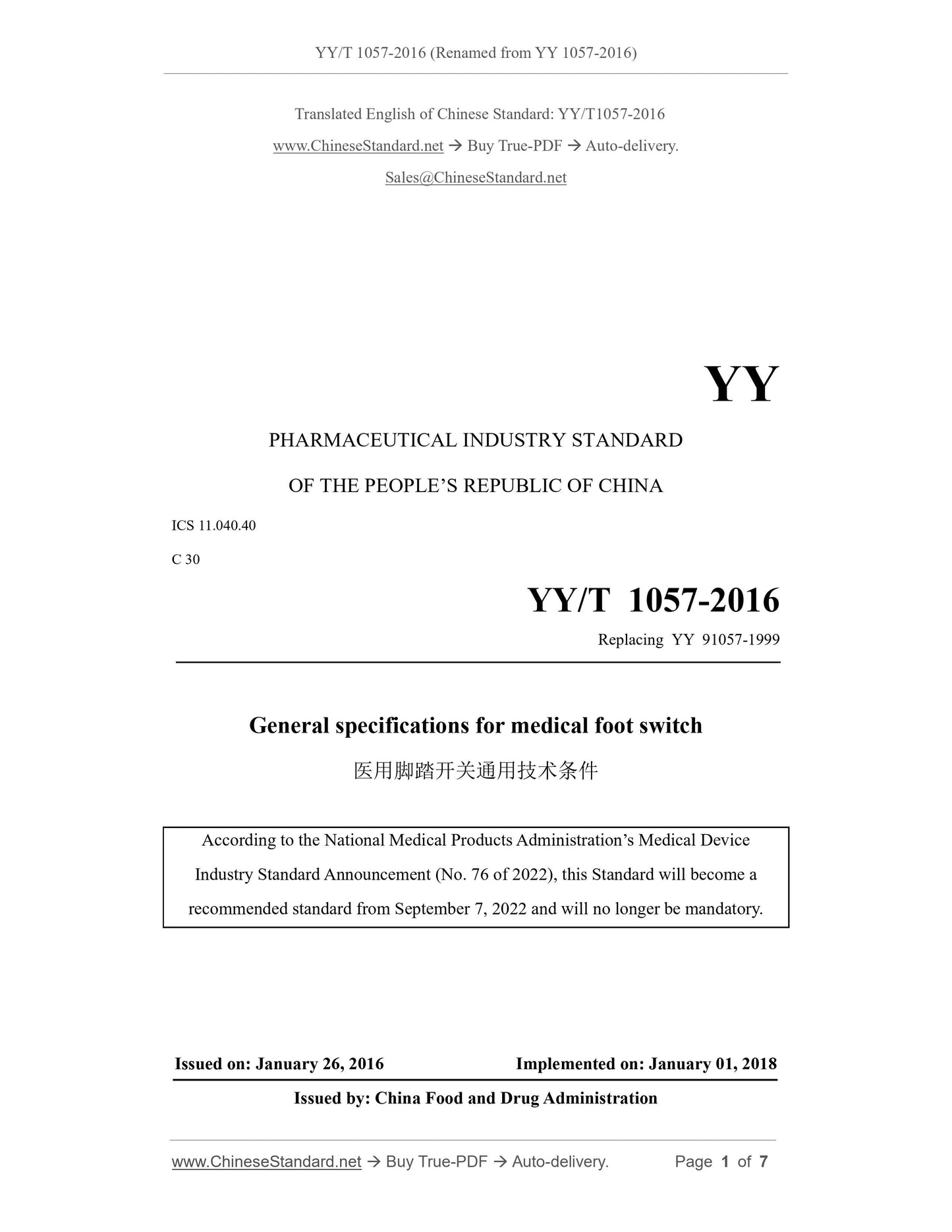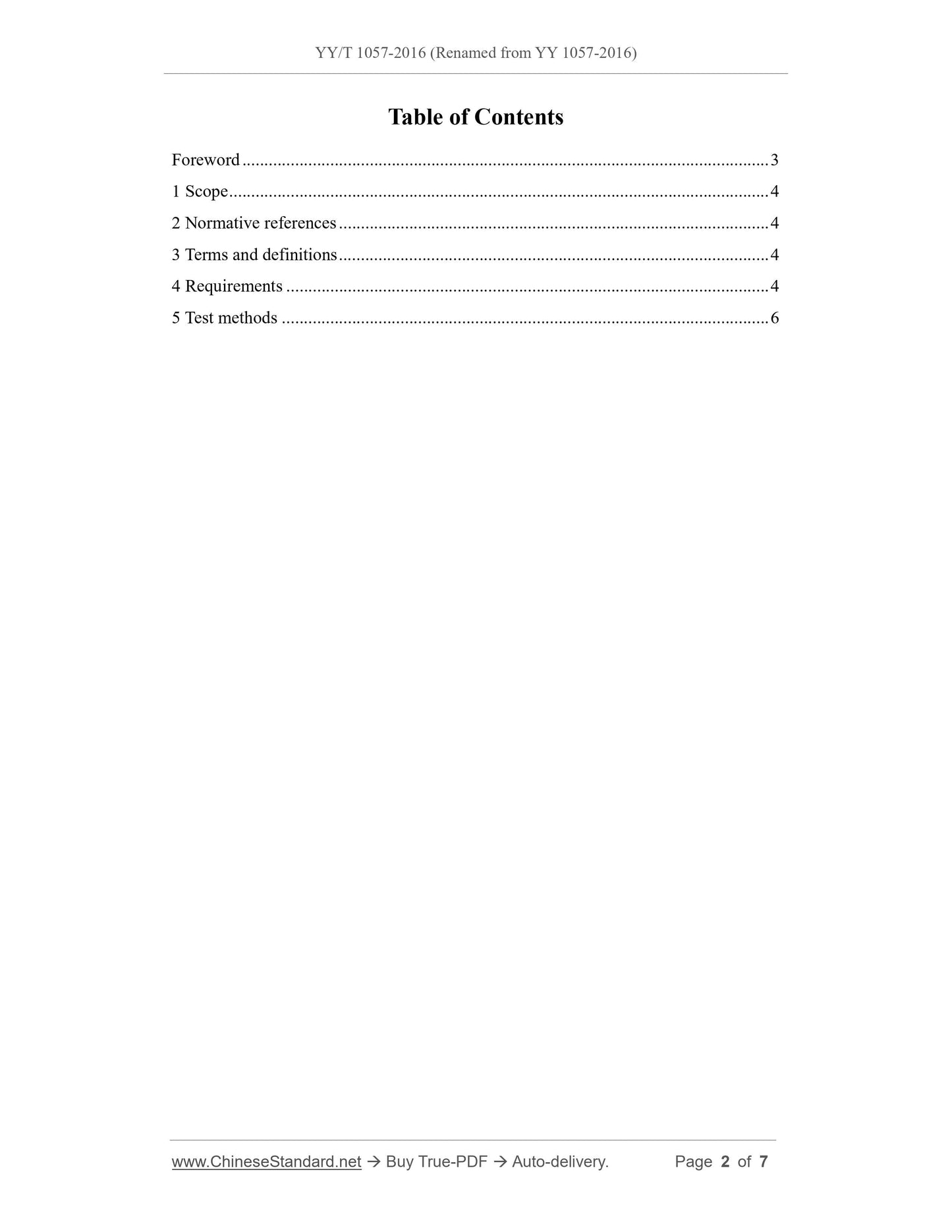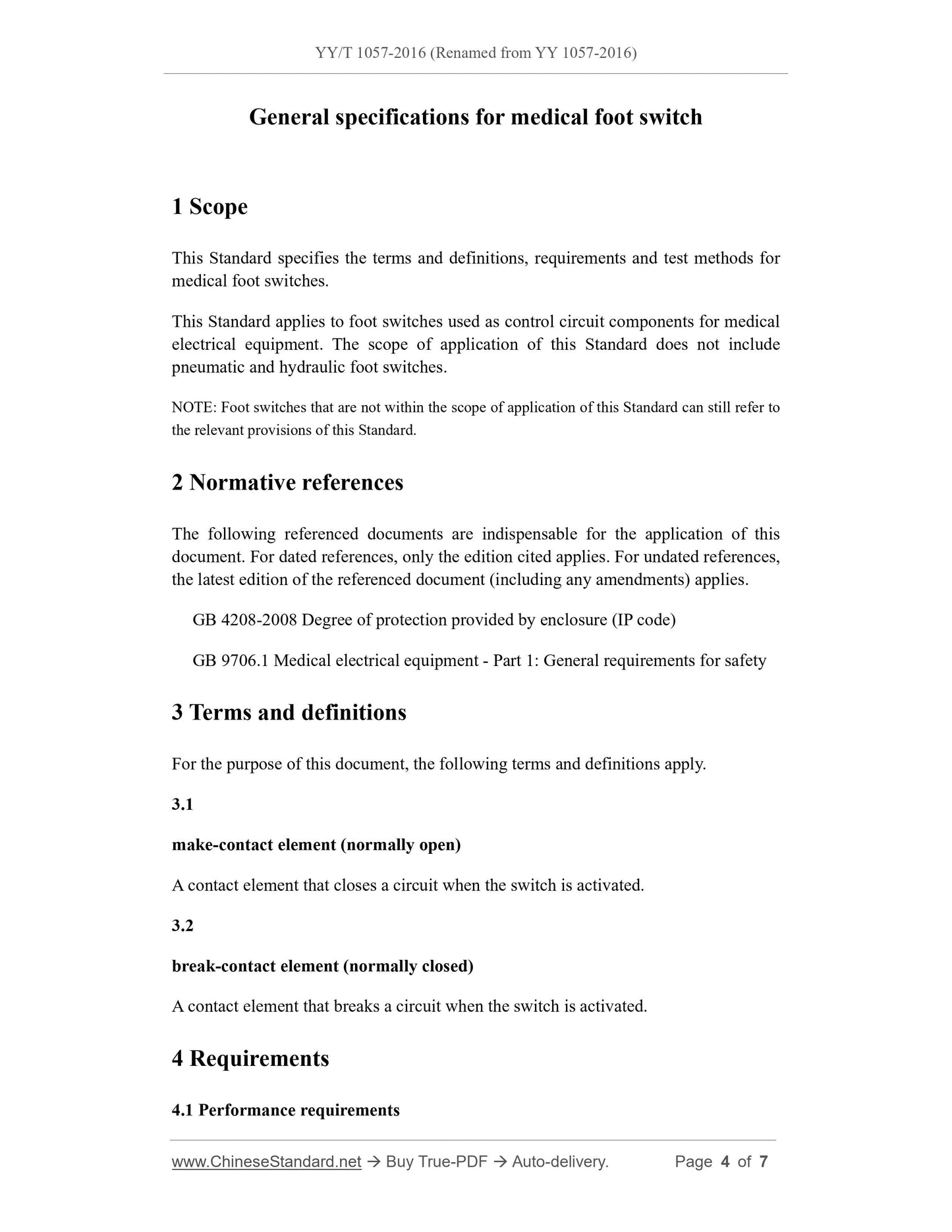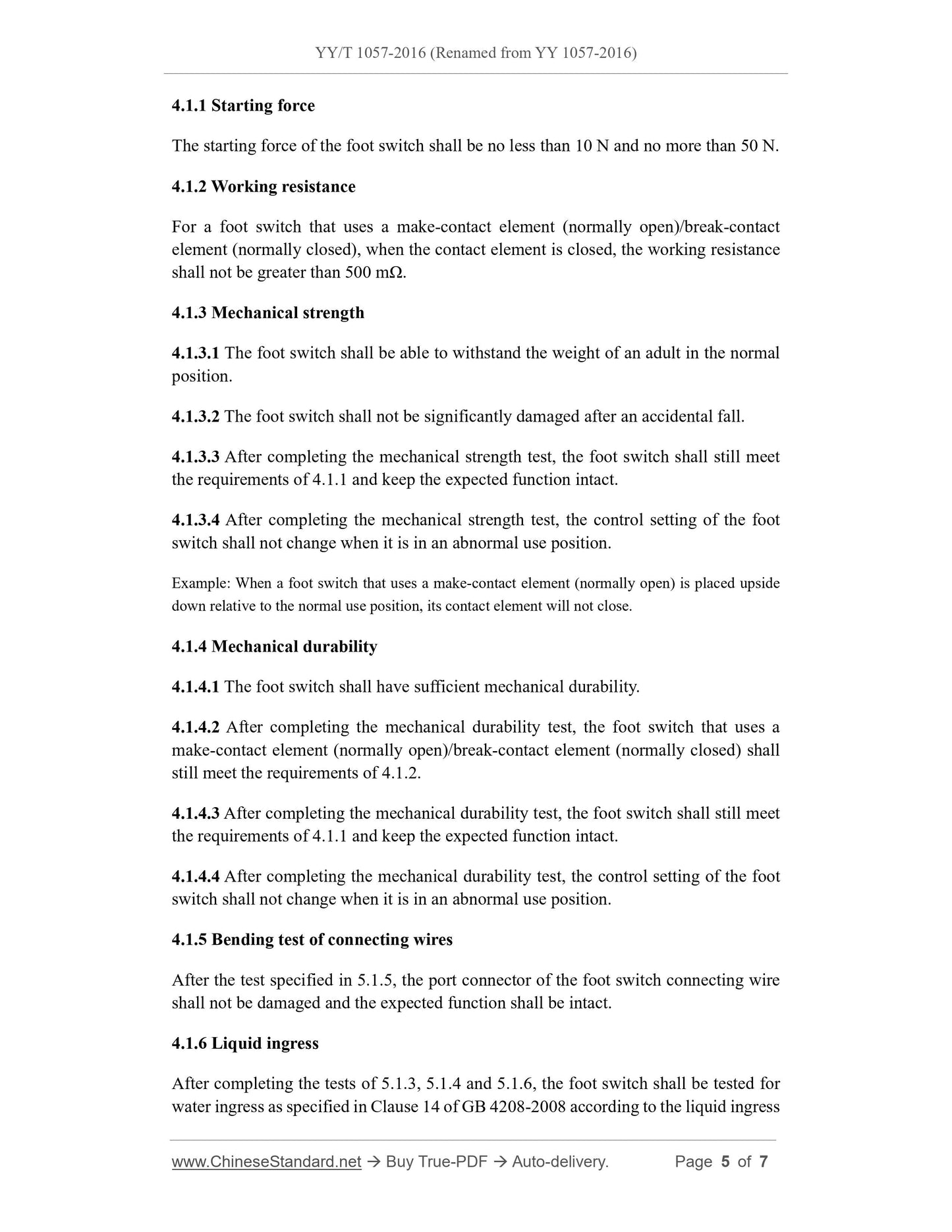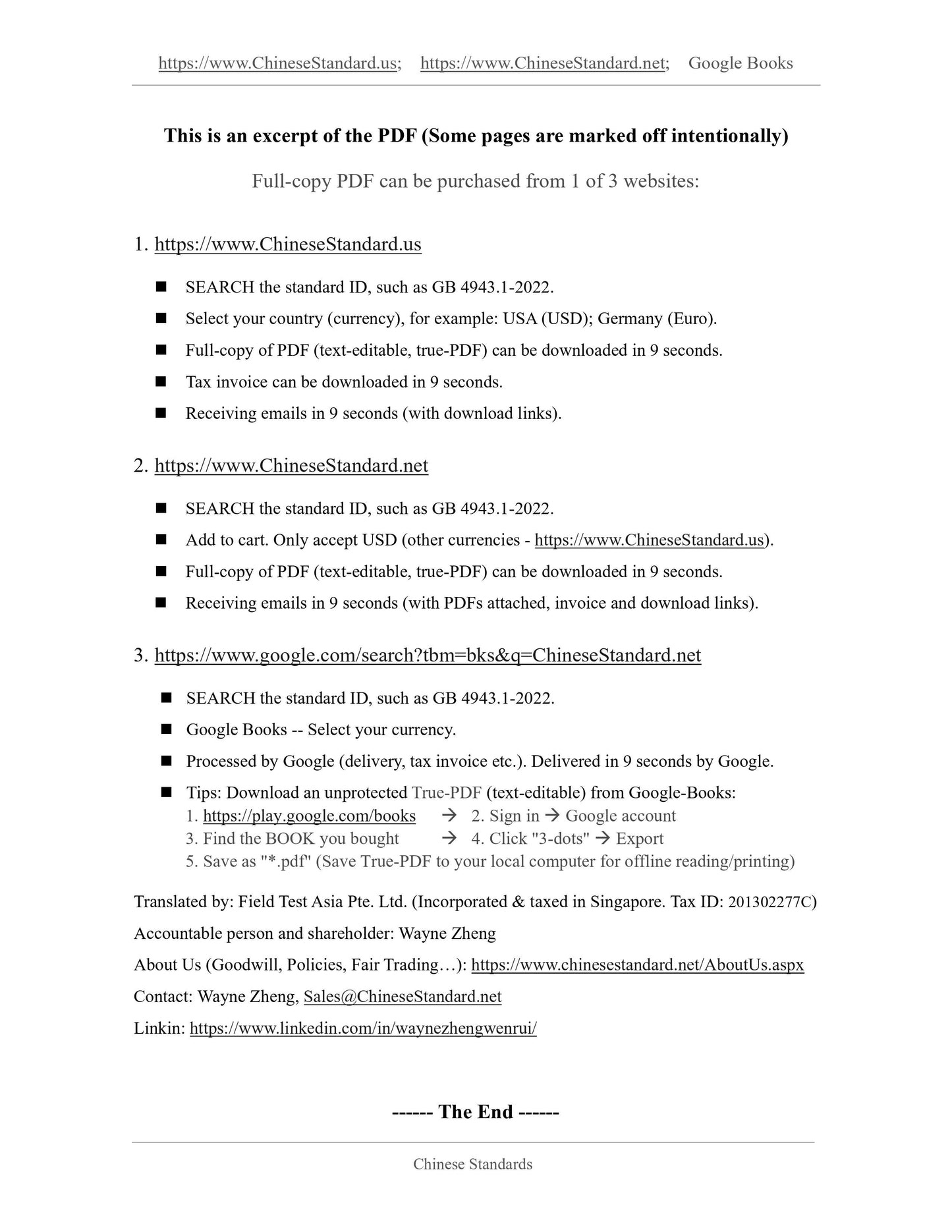1
/
의
5
PayPal, credit cards. Download editable-PDF and invoice in 1 second!
YY/T 1057-2016 English PDF (YYT1057-2016)
YY/T 1057-2016 English PDF (YYT1057-2016)
정가
$130.00 USD
정가
할인가
$130.00 USD
단가
/
단위
배송료는 결제 시 계산됩니다.
픽업 사용 가능 여부를 로드할 수 없습니다.
Delivery: 3 seconds. Download true-PDF + Invoice.
Get QUOTATION in 1-minute: Click YY/T 1057-2016
Historical versions: YY/T 1057-2016
Preview True-PDF (Reload/Scroll if blank)
YY/T 1057-2016: Genral specifications for medical foot switch
YY/T 1057-2016 (Renamed from YY 1057-2016)
YY
PHARMACEUTICAL INDUSTRY STANDARD
ICS 11.040.40
C 30
YY/T 1057-2016
Replacing YY 91057-1999
General specifications for medical foot switch
According to the National Medical Products Administration’s Medical Device
Industry Standard Announcement (No. 76 of 2022), this Standard will become a
recommended standard from September 7, 2022 and will no longer be mandatory.
ISSUED ON. JANUARY 26, 2016
IMPLEMENTED ON. JANUARY 01, 2018
Issued by. China Food and Drug Administration
Table of Contents
Foreword... 3
1 Scope... 4
2 Normative references... 4
3 Terms and definitions... 4
4 Requirements... 4
5 Test methods... 6
General specifications for medical foot switch
1 Scope
This Standard specifies the terms and definitions, requirements and test methods for
medical foot switches.
This Standard applies to foot switches used as control circuit components for medical
electrical equipment. The scope of application of this Standard does not include
pneumatic and hydraulic foot switches.
NOTE. Foot switches that are not within the scope of application of this Standard can still refer to
the relevant provisions of this Standard.
2 Normative references
The following referenced documents are indispensable for the application of this
document. For dated references, only the edition cited applies. For undated references,
the latest edition of the referenced document (including any amendments) applies.
GB 4208-2008 Degree of protection provided by enclosure (IP code)
GB 9706.1 Medical electrical equipment - Part 1.General requirements for safety
3 Terms and definitions
For the purpose of this document, the following terms and definitions apply.
3.1
make-contact element (normally open)
A contact element that closes a circuit when the switch is activated.
3.2
break-contact element (normally closed)
A contact element that breaks a circuit when the switch is activated.
4 Requirements
4.1 Performance requirements
4.1.1 Starting force
The starting force of the foot switch shall be no less than 10 N and no more than 50 N.
4.1.2 Working resistance
For a foot switch that uses a make-contact element (normally open)/break-contact
element (normally closed), when the contact element is closed, the working resistance
shall not be greater than 500 mΩ.
4.1.3 Mechanical strength
4.1.3.1 The foot switch shall be able to withstand the weight of an adult in the normal
position.
4.1.3.2 The foot switch shall not be significantly damaged after an accidental fall.
4.1.3.3 After completing the mechanical strength test, the foot switch shall still meet
the requirements of 4.1.1 and keep the expected function intact.
4.1.3.4 After completing the mechanical strength test, the control setting of the foot
switch shall not change when it is in an abnormal use position.
Example. When a foot switch that uses a make-contact element (normally open) is placed upside
down relative to the normal use position, its contact element will not close.
4.1.4 Mechanical durability
4.1.4.1 The foot switch shall have sufficient mechanical durability.
4.1.4.2 After completing the mechanical durability test, the foot switch that uses a
make-contact element (normally open)/break-contact element (normally closed) shall
still meet the requirements of 4.1.2.
4.1.4.3 After completing the mechanical durability test, the foot switch shall still meet
the requirements of 4.1.1 and keep the expected function intact.
4.1.4.4 After completing the mechanical durability test, the control setting of the foot
switch shall not change when it is in an abnormal use position.
4.1.5 Bending test of connecting wires
After the test specified in 5.1.5, the port connector of the foot switch connecting wire
shall not be damaged and the expected function shall be intact.
4.1.6 Liquid ingress
After completing the tests of 5.1.3, 5.1.4 and 5.1.6, the foot switch shall be tested for
water ingress as specified in Clause 14 of GB 4208-2008 according to the liquid ingress
Get QUOTATION in 1-minute: Click YY/T 1057-2016
Historical versions: YY/T 1057-2016
Preview True-PDF (Reload/Scroll if blank)
YY/T 1057-2016: Genral specifications for medical foot switch
YY/T 1057-2016 (Renamed from YY 1057-2016)
YY
PHARMACEUTICAL INDUSTRY STANDARD
ICS 11.040.40
C 30
YY/T 1057-2016
Replacing YY 91057-1999
General specifications for medical foot switch
According to the National Medical Products Administration’s Medical Device
Industry Standard Announcement (No. 76 of 2022), this Standard will become a
recommended standard from September 7, 2022 and will no longer be mandatory.
ISSUED ON. JANUARY 26, 2016
IMPLEMENTED ON. JANUARY 01, 2018
Issued by. China Food and Drug Administration
Table of Contents
Foreword... 3
1 Scope... 4
2 Normative references... 4
3 Terms and definitions... 4
4 Requirements... 4
5 Test methods... 6
General specifications for medical foot switch
1 Scope
This Standard specifies the terms and definitions, requirements and test methods for
medical foot switches.
This Standard applies to foot switches used as control circuit components for medical
electrical equipment. The scope of application of this Standard does not include
pneumatic and hydraulic foot switches.
NOTE. Foot switches that are not within the scope of application of this Standard can still refer to
the relevant provisions of this Standard.
2 Normative references
The following referenced documents are indispensable for the application of this
document. For dated references, only the edition cited applies. For undated references,
the latest edition of the referenced document (including any amendments) applies.
GB 4208-2008 Degree of protection provided by enclosure (IP code)
GB 9706.1 Medical electrical equipment - Part 1.General requirements for safety
3 Terms and definitions
For the purpose of this document, the following terms and definitions apply.
3.1
make-contact element (normally open)
A contact element that closes a circuit when the switch is activated.
3.2
break-contact element (normally closed)
A contact element that breaks a circuit when the switch is activated.
4 Requirements
4.1 Performance requirements
4.1.1 Starting force
The starting force of the foot switch shall be no less than 10 N and no more than 50 N.
4.1.2 Working resistance
For a foot switch that uses a make-contact element (normally open)/break-contact
element (normally closed), when the contact element is closed, the working resistance
shall not be greater than 500 mΩ.
4.1.3 Mechanical strength
4.1.3.1 The foot switch shall be able to withstand the weight of an adult in the normal
position.
4.1.3.2 The foot switch shall not be significantly damaged after an accidental fall.
4.1.3.3 After completing the mechanical strength test, the foot switch shall still meet
the requirements of 4.1.1 and keep the expected function intact.
4.1.3.4 After completing the mechanical strength test, the control setting of the foot
switch shall not change when it is in an abnormal use position.
Example. When a foot switch that uses a make-contact element (normally open) is placed upside
down relative to the normal use position, its contact element will not close.
4.1.4 Mechanical durability
4.1.4.1 The foot switch shall have sufficient mechanical durability.
4.1.4.2 After completing the mechanical durability test, the foot switch that uses a
make-contact element (normally open)/break-contact element (normally closed) shall
still meet the requirements of 4.1.2.
4.1.4.3 After completing the mechanical durability test, the foot switch shall still meet
the requirements of 4.1.1 and keep the expected function intact.
4.1.4.4 After completing the mechanical durability test, the control setting of the foot
switch shall not change when it is in an abnormal use position.
4.1.5 Bending test of connecting wires
After the test specified in 5.1.5, the port connector of the foot switch connecting wire
shall not be damaged and the expected function shall be intact.
4.1.6 Liquid ingress
After completing the tests of 5.1.3, 5.1.4 and 5.1.6, the foot switch shall be tested for
water ingress as specified in Clause 14 of GB 4208-2008 according to the liquid ingress
Share
